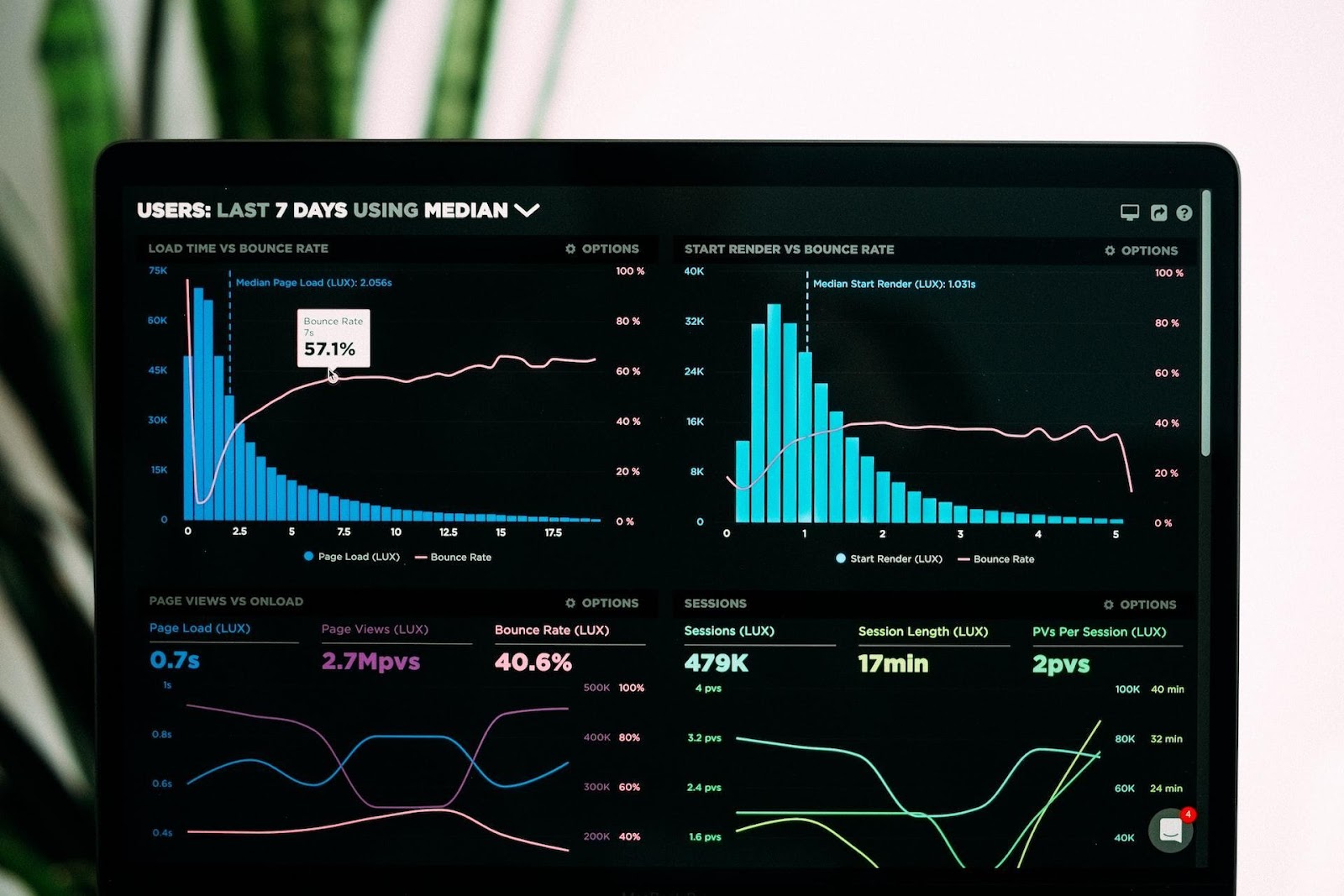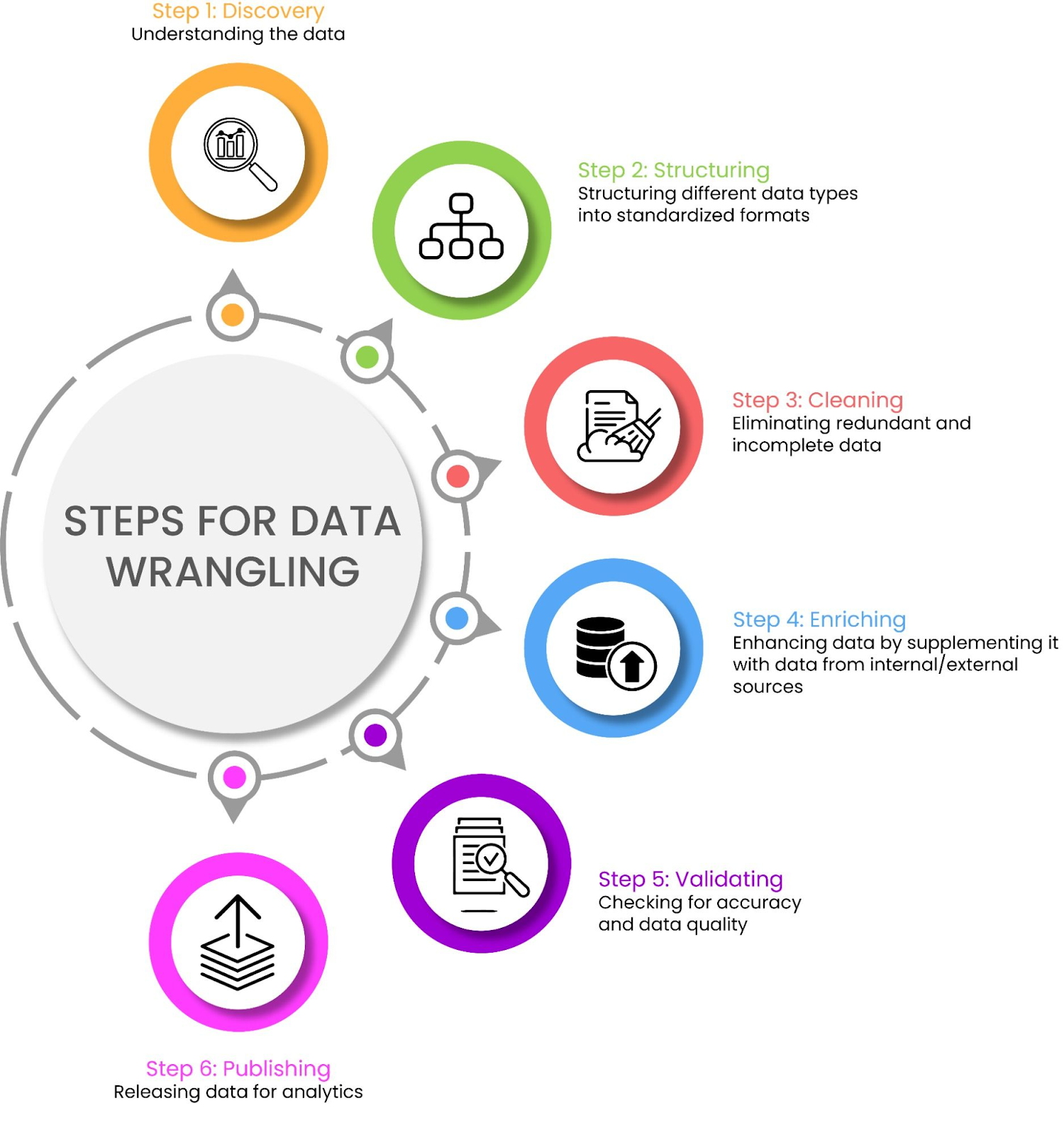Do you know recent research reveals that data wrangling practices are substantial for the future of data sciences? Data wrangling is the act of cleaning, changing, and mapping data from one basic form to another so it can be better utilized in subsequent processes, such as analytics. Since the volume of available data is constantly growing, proper data organization has become essential in today’s digital age of big data. Users in the corporate world rely heavily on data and information to apprise their decisions and prospects.
Therefore, cleaning up data to make it analytic-ready is crucial. Studies prove that data wrangling transforms the data for analysis, including cleaning, formatting, and mapping. Data wrangling, or data remediation and data munging, encompasses a wide range of operations meant to reformat raw data into more consumable articulations. The precise procedures vary from project to project based on the data being used and the desired outcome. Let’s dig deep to figure out the prominent aspects of data wrangling.
What is Data Wrangling?
Data wrangling is the cleaning and merging of disparate data sources to make them usable and straightforward for analysis. However, it’s becoming increasingly critical to store and organizes vast quantities of data for analysis as the amount of data. The number of sources of that data continues to grow exponentially. When raw data is cleaned, organized, and transformed into the desired format, analysts may make quick decisions based on the information.
Research shows that poor data quality can negatively influence decisions and results. Data wrangling helps businesses deal with more complex data in less time, with more accurate findings and better judgments—the specific procedures depend on the particular data and the clear objective of each project. Companies increasingly rely on data-wrangling solutions to prepare data for downstream analytics.
Some Examples of Data Wrangling:
Data wrangling techniques are used for a variety of purposes. The most common applications for data wrangling are:
- Combining multiple data sources into a single data set for analysis.
- Detecting gaps or empty cells in data and filling or deleting them.
- Removing unneeded or redundant information.
- Identifying significant data outliers and explaining or eliminating them to facilitate analysis.
Data-wrangling tools are also used by businesses to:
- Identify corporate fraud.
- Help with data security.
- Ensure consistent and accurate data modeling outcomes. Ensure business compliance with industry standards.
- Conduct a Customer Behavior Analysis.
- Recognize the business value of your data as soon as possible.
- Discover data patterns.
Essential & Best Data Wrangling Tools
- Spreadsheets / Excel Power Query – This is the most basic manual data-wrangling tool.
- OpenRefine is an automatic data-cleansing solution that requires programming knowledge.
- Nanonets can automate data transformation from PDF documents, images, and handwritten documents easily.
- Tabula is a tool that can handle various types of data.
- Google DataPrep is a data service that investigates, cleans, and prepares data.
- Data wrangler is a data cleaning and transformation tool.
- Talend is also a helpful Data Wrangling Tool.
- Trifacta is a cloud-based interactive data profiling and analytics software.
Want to automate data wrangling? Check out Nanonets now!
How Does Data Wrangling Work?
Data wrangling has become an essential component of data processing. The actual considerable work of data wrangling is as follows. Here’s how it improves the data quality:
Makes Raw Data Accessible
Data wrangling makes raw data accessible, and correctly wrangled data ensures that quality data is entered into the downstream analysis.
Cleanse Faulty/Missing Elements
Data wrangling processes combine raw data and clean the data noise or faulty or missing elements. This process involves acquiring data and making sense of it.
Creates Standard Format For Data
Data wrangling techniques such as automated data integration tools clean and convert source data into a standard format that can be used repeatedly based on end requirements.
Allows No Overlooking
Overlooking key data wrangling processes may result in substantial downfalls, missed opportunities, and incorrect models that will harm the organization’s reputation for analysis. So, it’s not allowed in data wrangling.

Image Source: Unsplash
Why Should You Use Data Wrangling?
Data wrangling is essential since it is the only way to turn raw data into actionable information. In the real world, information on customers or finances often arrives in bits and pieces, sourced from several locations and departments.
Here’s why you should use data wrangling:
It Eliminates Inaccuracy
Data wrangling eliminates the issues like data duplication and inaccurate data that can be a reason for multiple storage places, such as numerous computers, spreadsheets, and systems, including legacy systems.
It Provides an Accurate Picture of Your Business
The easiest way to get an accurate picture of what’s going on in an organization is to have all relevant data in one place. A skilled data wrangler can use the information to draw conclusions and hypotheses.
It Causes Increased Productivity
Through the data wrangling process, errors in data are mitigated, and procedures are mapped out to lessen reliance on key individuals. Low-manual tasks are eliminated, and employees can focus on high-value activities. As a result, businesses benefit from increased productivity and deeper insights from employees.
It Tame Data to Examine Quickly
Once raw data has been tamed and processed, it can be examined quickly and efficiently by business analysts and stakeholders.
It Delivers Real-Time Insights
Data wrangling converts free-form textual content into a tabular format. This method enhances the data for more significant real-time insights.
Want to automate repetitive data tasks? Check out Nanonets workflow-based data processing software.
How To Do Data Wrangling? – Step By Step Approach
Each data project calls for a one-of-a-kind strategy to guarantee that the final dataset is trustworthy and easily accessible. Nevertheless, the system is often based on some processes. These are frequently referred to as data-wrangling steps that are mentioned below:

Image Source: Turing
Discovery of Data
Discovery is the action of learning about information to form ideas about its potential applications. It’s the equivalent of checking the fridge for food before preparing dinner. During this phase, you may find problems like missing or incomplete values and underlying trends and patterns in the data. This is a crucial stage since it will shape the rest of the process.
Structuring of Data
Due to its incompleteness or improper format for the intended use, raw data is often useless before being processed. In data structuring, raw data is transformed into information that may be used more effectively. Your data will take on a specific shape based on the analytical framework you employ.
Cleaning of Data
Errors in the data can skew your analysis and reduce the quality of your results. Thus, it’s essential to clean your data before using it. Some examples of cleaning operations are the elimination of duplicates, the elimination of outliers, and the standardization of inputs. The purpose of data cleaning is to eliminate or reduce the number of mistakes that could affect the outcome of an analysis.
Enrichment of Data
Once you have a firm grasp of your data and have cleaned it up so that it can be used effectively, you will need to check to see if it contains all you need to complete your current endeavor. If that isn’t the case, you can select to “enrich” your data by adding in values from external sources. This is why it’s crucial to learn about the numerous use cases of data.
Validation of Data
If you want to make sure your data is reliable, you need to validate it. Validation is the process of checking whether or not your information is free of errors and, therefore, appropriate for analysis. Programming is often required for the many automated processes used in validation.
Publication of Data
Your data is ready for publication after verification has been completed. Sharing it internally for review is a necessary step in this process. Whether you choose to distribute the data in the form of a paper report or an electronic file will be determined by the specifics of the data you have collected and your company’s needs.

Image Source: Unsplash
What Are The Best Practices For Data Wrangling?
Many approaches and practices to data wrangling can vary with the specific readers or viewers. The following are some best practices that can be used in any situation:
Focused Demographics
The particular requirements for data wrangling vary from one business to the next. You must know who will use the data and for what purpose if you want to protect it from unwanted eyes. Through this method, you can gather data that will help you better understand your target demographic. For instance, collect detailed demographic information on your current clientele.
Use Efficient Tools & Techniques
Audiences grow steadily, and each day brings new combinations of technologies. To deliver effective data-wrangling services, data specialists must learn to use new tools and analytics technology.
Focus on Appropriate Data
Having a large amount of data isn’t necessary; instead, having accurate data is. For this reason, picking the proper chunks of data is essential. Do not use information with a high prevalence of blanks or repeated or recurring integers. To do this, you’ll need to collect data from various sources. You can sort the information according to your criteria, then pick a subject that fits the bill.
Identify Ins & Outs
You must recognize how the data satisfy the governance standards of your company. It would help if you understood the ins and outs of the data, the database, and the many file formats. In addition, take advantage of the features offered by visualization tools to investigate the current state of the data. By characterizing your data, you can generate metrics to measure the quality of your data.
What Are The Different Use Cases of Data Wrangling?
A few of the most crucial use cases of data wrangling in economics and enterprise are listed below:
Data Wrangling for Financial Insights
Data wrangling is a powerful tool for financial analysts in the business sector, allowing them to unearth actionable insights about potential investments. Data wrangling carefully addresses inquiries about the markets and sectors to inform investment decisions.
Data Wrangling for Increased Transparency
There is a continuous demand for reports from many divisions inside financial institutions and other enterprises. However, raw and unstructured data showing these outcomes can make it challenging to communicate the findings effectively. A better comprehension of the data is reached by management thanks to the work of a data wrangler.
Data Wrangling for Company’s Standardized Layout
Depending on the needs of each division or division of a corporation, data collection may be handled through a variety of different systems. The ability to consolidate and compare data from multiple sources is a crucial benefit of data wrangling.
Data Wrangling to Know Customers
Due to the diversity of your clientele, the information you collect on them may range widely. Customer preferences for certain items can be better understood with the help of data wrangling, which highlights underlying patterns and commonalities across customers.
Data Wrangling for Quality of Data
Data wrangling is used when the quality of the data being worked with needs to be enhanced. Whether you’re a financial analyst or the head of the marketing department, you need high-quality data to conclude it. The various steps of data wrangling can help you get there.

Image Source: Unsplash
Want to automate data wrangling? Try Nanonets software to automate data wrangling from document data on the go.
Data Wrangling for Enterprises
Enterprises have varying data-use strategies. In a business, raw data passes through several different procedures. These operations remodel information so it can be read and used in several studies. The usage of data lineage enables businesses to keep tabs on these kinds of information assets and aids analysts in determining the origins of errors. Knowing how to decipher data is crucial for leading firms to success. There are numerous methods for performing data wrangling.
Here’re the Best Data Wrangling Guidelines for Enterprises
If you want to save time and get the most out of the process, follow these guidelines:
Analysis of Data
It helps immensely in data wrangling if you know your audience. You can better tailor your efforts to the users’ requirements and objectives if you know who will access and use the data. This information is helpful if organizations want to demonstrate their capacity for earning income, but additional segmentation is required if cost-cutting is the primary objective.
Use Relevant Data
Data quantity is less important than data quality. Wrangling data is essential because it gives clean data for further study.
For instance,
- It would help if you tried to keep your entries unique and avoid making duplicates or empty ones.
- Do not rely on just one data source when doing research. Change up your informational sourcing.
- Sort information according to specified criteria.
- Think critically about the information.
Specify Data
You should also be aware of how your data interpretations’ results relate to your organization’s requirements. You can locate the many types of databases and files. However, the quality metrics for data can be generated as needed. The constraints in the data must be treated with caution.
Converge Data
There may be an opportunity for improvement or inaccuracies in wrangled data, no matter how well it’s optimized. Review jumbled information to check for errors and identify ways to make it more efficient. Analysts might discover ways to improve quality, for instance, when they manipulate financial data. Invoices that haven’t been paid yet can be linked to estimates of when those payments will be made, and operational mistakes can be spotted.
Transform Data
Raw data can be better analyzed, interpreted, and cleaned up with the help of data wrangling. Even while it takes time, it prevents you from sifting through data that isn’t relevant to your problem. The result is a consolidated view of pertinent information that can be used to improve operations.

Image Source: Unsplash
If you worry about data wrangling, check out Nanonets to automate data tasks for free. Click below to learn more about Nanonets.
Data Wrangling Automation
Most firms would benefit immensely from automating the majority of their data wrangling. It takes less time, costs less money, and results in fewer errors. A new generation of startups employ machine learning and artificial intelligence to deliver automated data-wrangling solutions that also present data within easy-to-use dashboard systems and provide regular notifications and data-based recommendations as a result of these industrial breakthroughs. Business decisions will now be based on valid data, vastly increasing the chances of good results.
Is Data Wrangling Automation Right for Your Business?
Some common examples of businesses that undergo evolutionary transformation through automated data wrangling are:
- Firms in the energy industry are interested in learning about consumer habits and enhancing network efficiency.
- Businesses in the consulting industry want to provide their clients with additional data-driven insights.
- Businesses operating in e-commerce need to understand customer behavior and act accordingly. They can benefit from automated data wrangling.
- To have a deeper understanding of campaign statistics, many marketing agencies turn to automation of data wrangling.
- Companies in the manufacturing and logistics sectors are also trying to streamline their processes and supply networks.
Requesting a free consultation and carefully considering the advantages will help you decide whether automated data wrangling is proper for you.
How Does the Automation of Data Wrangling Work?
Data wrangling automation has always been challenging since it does not entail the simple automation of repeated procedures. It is finding excellent data, removing poor data, and converting it to the needed format. So on, all demand a high level of intelligence, which is a prerequisite for data wrangling. A team of data scientists or engineers was previously required to build, test, deploy, and review algorithms within a live environment.
This is where advances in artificial intelligence and machine learning come in. These two techniques, called AutoML or “automated machine learning,” have revolutionized our ability to interpret raw datasets quickly and made this power accessible to those who are not specialists.
Benefits of Data Wrangling Automation
- Using automation can save a significant amount of time. Instead of doing activities by hand, you can have software do them while focusing on more essential things.
- Collecting, processing, transforming, and analyzing data can waste time and money. On the other hand, data automation can accomplish all of these things better, faster, and at a lower cost.
- Whereas humans can make mistakes, data automation software does not. The software collects, alters, uploads, and analyzes massive amounts of data with extreme precision and accuracy.
- With data automation, you may better utilize your personnel as the program handles uninteresting and tiresome jobs.
Find out how Nanonets’ use cases can apply to your product.
 NEWSLETTER
NEWSLETTER




